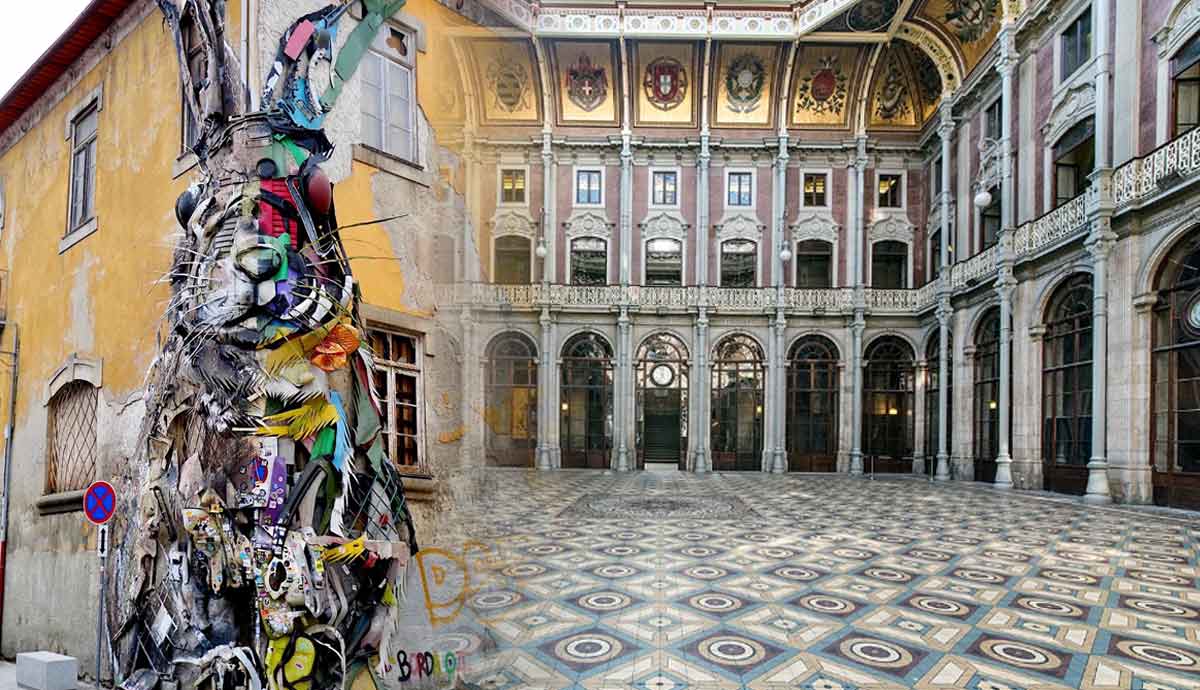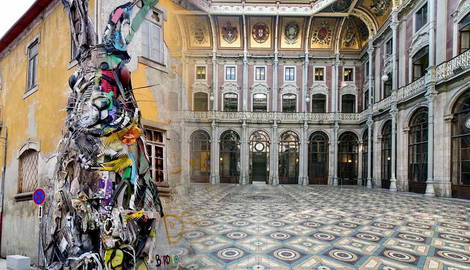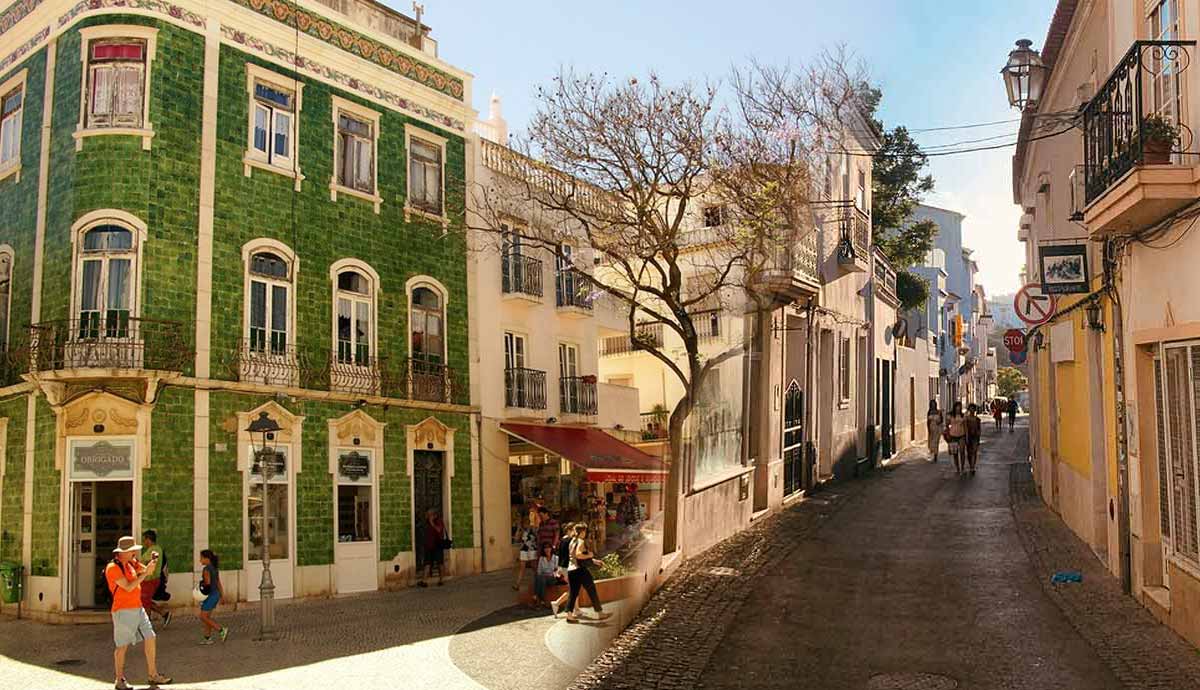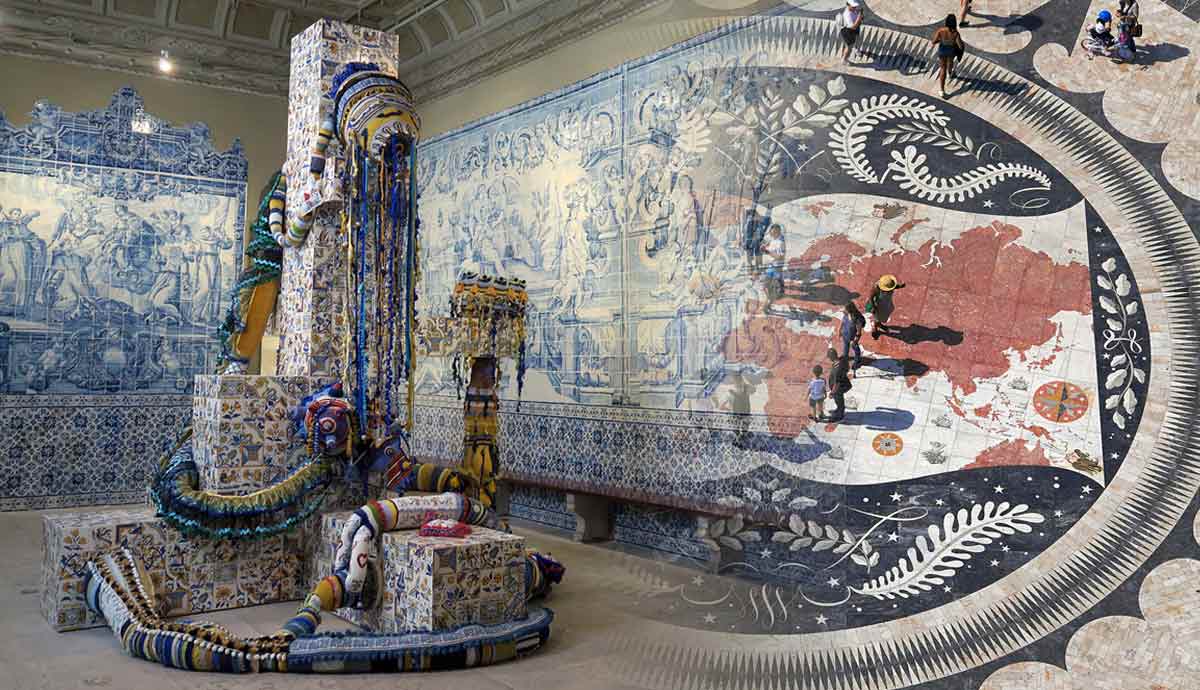
Porto is famous for its incredible past and its monuments. This mesmerizing city holds some of the most iconic historical buildings in the country besides renowned contemporary art galleries.
Baroque, Neo-Classical, and Art Nouveau Landmarks
Igreja and Torre dos Clérigos

Built in 1779, the Clérigos Church and Tower are among the oldest and most emblematic buildings in Porto. Italian architect Nicolau Nasoni was responsible for the buildings’ design. After his death, Nasoni was buried in a crypt under the church’s main altar.
The church and tower façades display captivating Baroque decorations. The buildings’ design shows irregular and exaggerated forms, which create a surprising effect. Here, you can find irregular floor plans, undulating façades with protrusions, balconies, recesses, arches, windows, and the iconic bell tower. In the gable, Nasoni combined straight and semicircular lines decorated with ornamental and symbolic motifs, such as bundles of plants, vases, and mantels.
Embellished Baroque gilded wood covers the church’s granite and marble interior and the chancel features a polychrome altarpiece by Manuel Porto. However, the most striking element in this complex is the granite Clérigos Tower, rising from the western side of the church. Torre dos Clérigos was the tallest building in Portugal at the time of its completion, at 75 meters (246 feet) high. Inside the tower, you must walk 225 steps to the top and admire the Baroque crown and stunning panoramic view over Porto.
Bolsa Palace

Palácio da Bolsa is a Portuguese National Monument symbolizing the city’s economic power in the 19th century. Built between 1834 and 1908 over the ruins of Saint Francis Convent, it quickly became the city’s drawing room, welcoming monarchs, heads of state, and ministers from several countries.
This impressive and eclectic palace was designed to provide the city’s businessmen and merchants a place to discuss trade and build new commercial relationships. The result is a magnificent palace where several architectural styles blend to form a unique structure in Portugal.

At Bolsa Palace, you can admire features of the 19th-century Neoclassical and English Neopalladian architecture styles. However, the most iconic room is the Arab Hall. Its walls and ceiling are covered in stuccos with gold Arabic lettering, creating a rich and captivating ambiance.
São Bento Train Station

São Bento Train Station is a stunning early 20th-century building built over the former São Bento de Avé Maria convent. King Carlos I laid the foundation stone. It was designed by architect José Marques da Silva and completed in 1916.
French architecture influenced the façade design, resulting in a charming landmark that welcomes visitors from all over Portugal.
Inside, you will find a wide atrium with walls covered in more than 20,000 traditional Portuguese blue and white panels by artist Jorge Colaço. The tiles were painted between 1905 and 1908 and depict the evolution of transportation, historical events and mythology, and traditional outfits and agricultural work.
Real Fábrica de Louça de Sacavém made the tile panels, following the nationalist and historicist style, as was customary in the early 20th century. These tiles cover the entire wall inside the atrium and are incorporated into the building design by granite framing covering the openings. The tile panels are organized in chronological order, following a vertical hierarchy.
In 1997, the Portuguese Government declared São Bento Train Station a Property of Public Interest. In the years that followed, renowned publications such as North American Travel + Leisure and Flavorwire magazines ranked São Bento Train Station as one of the most beautiful train stations in the world. In 2024, European Best Destinations magazine also ranked this stunning Porto landmark as one of the most beautiful train stations in Europe.
Livraria Lello

Livraria Lello is a bookshop and publishing house famous for its Neo-Gothic building with Art Nouveau features, built in the early 20th century.
On the façade, you can admire a large arch and two side windows that define the building’s entrance. Take some time to admire the pilasters topped by corbels with Neo-Gothic arched openings.
Inside, you will marvel at the magnificent wooden red-carpeted staircase spiraling up toward a colored glass ceiling. Beside it, you can admire several rows of books arranged on ornate wooden shelves extending to the ceilings decorated with intricate plaster designs. The large murals depict impressive scenes from Portuguese literature.
Due to its beauty and uniqueness, British newspaper The Guardian, CNN International, and travel guide Lonely Planet have named Lello Bookstore one of the most beautiful bookstores worldwide.
Contemporary Art Galleries
Fundação Serralves

Serralves Foundation is an art foundation focused on raising public awareness of contemporary art and the environment. It was founded in 1989, and today, the building complex includes a villa (Casa de Serralves), a park, and a contemporary art museum (Serralves Contemporary Art Museum).
Casa de Serralves was built in the early 19th century by the second Count of Vizela, Carlos Alberto Cabral, as a Summer house. The building designed by José Marques da Silva shows the influence of French architecture and decorative elements. It is often considered a unique example of the Art Deco architecture in Portugal.
In the 1980s, Casa de Serralves opened to the public as an exhibition space until 1999, when the Serralves Contemporary Art Museum was publicly open. The Serralves Contemporary Art Museum, designed by the 1992 Pritzker Architecture Prize winner Álvaro Siza, opened in 1999. Today, the museum is the primary exhibition space, where you can admire several installations and sculptures.
Inside the 13,000 square meters (140,000 square feet) building, you can wander the 14 galleries spread across 4,500 square meters (49, 000 feet) of exhibition space. The museum collection includes direct acquisitions, works deposited by the Portuguese government, and donations.
Although there are no permanent exhibitions, you can admire the artworks of invited artists. In recent years, Serralves Museum has hosted the works of Ana Jotta, Luc Tuymans, and Christopher Wool, among many others.
Galerias MIRA

Photographers Manuela Matos Monteiro and João Lafuente founded the MIRA Galleries in the Campanhã neighborhood, the first in this area, in 2013. The galleries are installed in an early 20th-century building redesign by architect Adriana Floret. The heavy granite walls contrast with the pieces on display.
Monteiro and Lafuente created a space where photographers could meet, discuss new ideas, and display their works. This was the idea behind the photography-focused MIRA Galleries.
More than ten years later, MIRA Galleries (which include the Espaço MIRA and the MIRA Fórum) hosted more than 229 exhibitions, including 170 lectures and 120 book launches.
Galeria Fernando Santos

Fernando Santos Gallery was established in 1993 at Rua Miguel Bombarda, Porto’s cultural area. Its purpose was to promote contemporary projects and artists by presenting them to curators and audiences.
The gallery program promotes the works of the artists it represents and their careers. It does so by showing them in its own spaces or promoting their tours in museums in Portugal and abroad.
Besides the main space dedicated to temporary exhibitions, at Fernando Santos Gallery, invited artists can display their artwork along the CUBO space of 1,200 square meters (13,000 sq feet).
Here, you can find the works of Portuguese artists Ana Vidigal, Cristina Massena, Cristina Mateus, and João Louro, and the international artists Saint Clair Cemin, Santiago Ydáñez, and Ray Smith.
Galeria Nuno Centeno

Nuno Centeno, son of the famous Portuguese painter Sobral Centeno, founded its art gallery in 2007. Over the years, the gallery expanded, leading Nuno Centeno to join international art fairs. Artnet ranked Nuno Centeno Gallery among the top ten most reputable galleries in Europe.
The gallery is located at the old Stonemasons Cooperative building, keeping its industrial design. Here, you can admire temporary exhibitions that extend to a maximum of two months.
At Nuno Centeno Gallery, you can observe paintings, installations, and sculptures from several artists such as Ana Cardoso, Blake Rayne, Bosco Sodi, and Dan Rees.
Galeria Presença

Opened in 1995, Presença Gallery hosts the works of Portuguese and international emerging contemporary artists. From paintings to installations, you admire several temporary exhibitions showing curated works throughout the year.
Presença Gallery promotes the sharing of ideas between different institutions, curators, critics, and collectors to promote its artists by constantly showing their works. Gustavo Sumpta, Lia Chaia, Isaque Pinheiro, Mafalda Santos, and Roland Fischer are among the artists displayed at the Presença Gallery.
Street Art
Wandering Porto streets will allow you to admire the city’s urban art. Renowned and emerging urban artists have left their mark on the building’s façades all over the city.
Don Quixote and Sancho Panza

In 2013, Mesk, Fedor, and Mots immortalized Cervantes’s classic characters on the side of a 130-square-meter (1,400-foot) building. It was the first non-commissioned legal mural in Porto when urban art first emerged in the city. Circus Network was responsible for coordinating the work.
Quem és Porto? (Who Are You, Porto?)

More than 3,000 ceramic tiles compose this stunning piece. Its goal is to answer the question “Who are you, Porto?” described at the center. Dozens of people were assigned four tiles each to which they replied with what they believe best defines the city. The result is an impressive tile mural idealized by ±maismenos±, a group of social and political activists in Portugal.
an.fi.tri.ão

Porto’s hospitality is such a defining feature of the city’s charm that artist Frederico Draw captured it in this work. On the side of a building at Avenida Vímara Peres, Draw created a portrait of his grandfather welcoming everyone entering the city via the D. Luís Bridge upper deck. It may be one of the artist’s most personal works and one of the most popular among the city’s residents.
Half Rabbit

Bordalo II is the author of this incredible piece. In 2017, the Portuguese artist sculpted a two-story rabbit on a building façade from rubbish he collected around Gaia Quay.
Located on the corner of Guilherme Gomes Fernandes Street and Dom Alfonso 111 Street in Vila Nova de Gaia, the rabbit is half-colored and half-gray to show people the material’s original colors. Bordalo II wants to raise awareness about consumerism and pollution through his artwork.
A Tribute to Healthcare Workers

Outside Hospital de São João, Porto’s largest hospital, is a unique piece by the artist Vhils. It is a tribute to the doctors, nurses, and health professionals who fought the Covid-19 pandemic on the frontline. The renowned artist peeled and carved the walls to design a few masked faces portraying these healthcare professionals.
Look at Porto

This is another of Vhils’s masterpieces in Porto. The traditional and austere building façade at Atafona Street was Vhils’s canvas to form a human eye gazing upon the city and its old neighborhoods.
Mira

At Rua Nova da Alfândega Street, you can admire Mira, an impressive mural by Daniel Eima portraying an old woman from the neighborhood. The artist’s goal was to represent the city’s simple lifestyle. Eima is a talented stencil artist who often combines spray and static art with black and white brush paintings.
Mural da Trindade

This is one of the most iconic urban art pieces in Porto. Next to the Trindade car park, you will find this incredible mural painted by Hazul Luzah and Mr. Dheo in 2014. This was one of the first murals commissioned by the Porto City Council. The 250 square meters (2,690 sq foot) wall depicts a faceless figure with round eyes designed by Hazul and a hyper-realistic portrait by Mr. Dheo, who drew his father.










